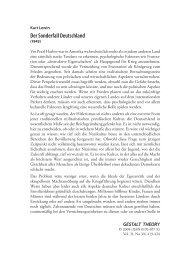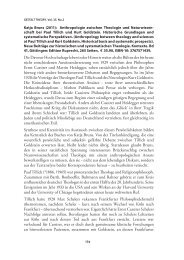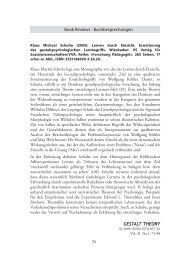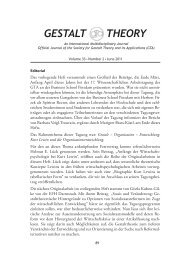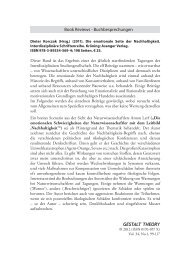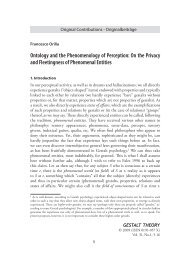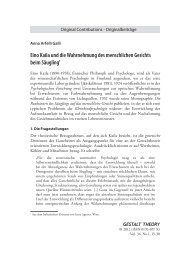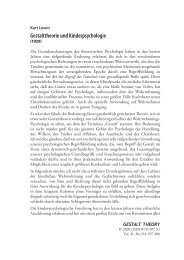What is the Meaning of Shape? - Gestalt Theory
What is the Meaning of Shape? - Gestalt Theory
What is the Meaning of Shape? - Gestalt Theory
You also want an ePaper? Increase the reach of your titles
YUMPU automatically turns print PDFs into web optimized ePapers that Google loves.
389<br />
Pinna, <strong>What</strong> <strong>is</strong> <strong>the</strong> <strong>Meaning</strong> <strong>of</strong> <strong>Shape</strong>?<br />
3.2.2. Rotated Square<br />
Fig. 2b represents an intermediate but crucial step in answering <strong>the</strong> previous<br />
questions. Th<strong>is</strong> figure <strong>is</strong> mostly described as a rotated square. Under <strong>the</strong>se<br />
conditions, subjects introduced spontaneously information about orientation,<br />
thus, creating a two-word description. The rotation becomes now v<strong>is</strong>ible, noticeable<br />
like a figure. The exact orientation <strong>is</strong>, instead, not specified spontaneously in<br />
words. Only after asking <strong>the</strong>m to describe <strong>the</strong> apparent direction and degree <strong>of</strong><br />
rotation, our subjects reported ~10° anticlockw<strong>is</strong>e.<br />
These results suggest a tw<strong>of</strong>old perception: a “true” square plus something that<br />
happens to it, namely, <strong>the</strong> rotation. In o<strong>the</strong>r words, unlike Fig. 2a <strong>the</strong> square <strong>is</strong>,<br />
now, not only a square, but also a square with a “happening” (Pinna, 2010b)<br />
defined in terms <strong>of</strong> rotation. The anti-clockw<strong>is</strong>e rotation suggests some kind <strong>of</strong><br />
minimum rotation pathway starting from <strong>the</strong> “true” square <strong>of</strong> Fig. 2a.<br />
Structurally, th<strong>is</strong> happening <strong>is</strong> similar to those described for Figs. 1c-i.<br />
Lingu<strong>is</strong>tically, <strong>the</strong> rotation <strong>is</strong> an adjective that describes <strong>the</strong> noun, which <strong>is</strong> <strong>the</strong><br />
square. Phenomenally, it <strong>is</strong> what happens to <strong>the</strong> shape. The primary role <strong>of</strong> <strong>the</strong><br />
shape (square) in relation to <strong>the</strong> adjective (rotation) can be clearly perceived<br />
by comparing <strong>the</strong> two following possible descriptions: “a rotated square” and<br />
“a rotation with a square shape”. The second description appears meaningless<br />
and odd. A rotation cannot have a shape, while <strong>the</strong> shape can have a rotation.<br />
Th<strong>is</strong> suggests a clear asymmetrical hierarchy between <strong>the</strong> two terms. The shape<br />
<strong>is</strong> primary, earlier in time and order than <strong>the</strong> rotation. Therefore, <strong>the</strong> shape <strong>is</strong> a<br />
noun and as such it <strong>is</strong> a word generally used to identify a class <strong>of</strong> elements. As a<br />
noun, <strong>the</strong> shape <strong>is</strong> like “a thing”, which can appear in many different ways, and<br />
<strong>the</strong> rotation <strong>is</strong> one <strong>of</strong> th<strong>is</strong> ways <strong>of</strong> being <strong>of</strong> <strong>the</strong> shape, i.e. <strong>the</strong> attribute <strong>of</strong> that<br />
specific thing.<br />
These phenomenal observations suggest <strong>the</strong> following methodological note:<br />
<strong>the</strong> asymmetrical descriptions represent a useful method <strong>of</strong> understanding <strong>the</strong><br />
primary role <strong>of</strong> one v<strong>is</strong>ual component over ano<strong>the</strong>r, e.g. <strong>of</strong> <strong>the</strong> shape over <strong>the</strong><br />
rotation and, more generally, <strong>of</strong> something that becomes <strong>the</strong> primary thing over<br />
ano<strong>the</strong>r perceived like its attribute. Ano<strong>the</strong>r example useful to understand <strong>the</strong><br />
effectiveness <strong>of</strong> th<strong>is</strong> method <strong>is</strong> represented by <strong>the</strong> relation between shape and<br />
color: we say “a red square” and not “a square-shaped red”. The d<strong>is</strong>tinction<br />
between things and attributes can also be demonstrated through <strong>the</strong> position<br />
<strong>of</strong> <strong>the</strong> words one relative to <strong>the</strong> o<strong>the</strong>r and through <strong>the</strong> phenomenal inv<strong>is</strong>ibility,<br />
i.e. an attribute (way <strong>of</strong> being <strong>of</strong> a thing) can be inv<strong>is</strong>ible or unnoticed like a<br />
background much more than a thing.<br />
Despite th<strong>is</strong> asymmetry, rotation and square define <strong>the</strong>mselves reciprocally. The<br />
rotation <strong>is</strong> defined by <strong>the</strong> shape, i.e. <strong>the</strong> rotation can be perceived if and only<br />
if <strong>the</strong> square as a singularity <strong>is</strong> also perceived. Conversely, <strong>the</strong> rotation defines





